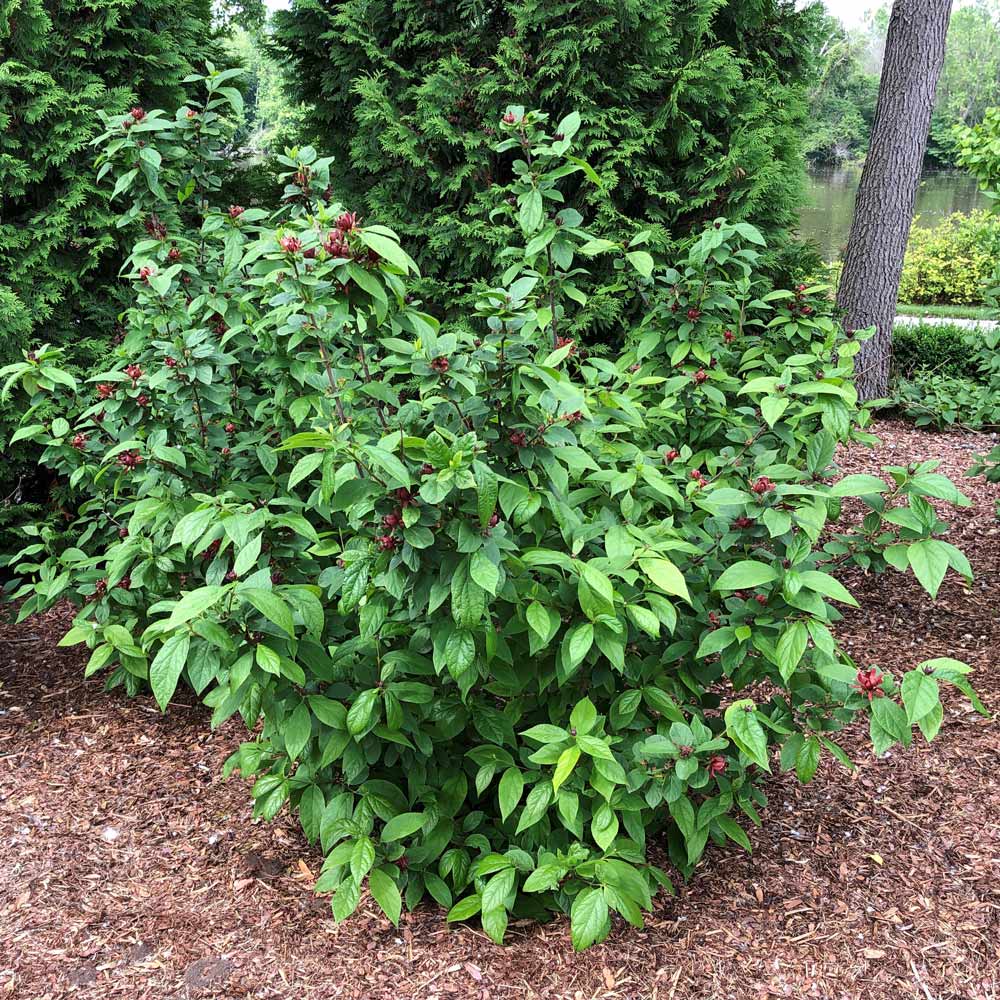Most gardens have a diversity of plants, usually with a representation of at least one or two categories. This would include annuals, perennials, shrubs, vines and trees. In the urban gardens of many homeowners today, there may be fewer trees and more shrubs due to limited space.
Sometimes the distinction between a shrub and a tree is very subjective, but usually a shrub will be shorter than a tree with multiple branches. Of course, this is not a hard and fast distinction because some trees can also be quite short and have multiple branches.
Using the above definition of a shrub, here are five shrubs that have commanded attention in my garden. None of them have needed any control measures for insects or diseases. They all survived the heat of last summer and the cold of this past winter and are looking good in our cool, very wet spring.
Perhaps one or more of these plants will demand attention in your garden, too.
 Sometimes referred to by the common name of Tasmanian pepperberry or mountain pepper, Drimys lanceolata is an evergreen shrub with red stems. There are clusters of white flowers in late spring, but the real attraction is the red stems. The stems are red throughout the year and provide a nice contrast to the dark green leaves.
Sometimes referred to by the common name of Tasmanian pepperberry or mountain pepper, Drimys lanceolata is an evergreen shrub with red stems. There are clusters of white flowers in late spring, but the real attraction is the red stems. The stems are red throughout the year and provide a nice contrast to the dark green leaves.
The specimen in my garden is probably 25 years old and is planted in a sunny location. It is about 6 feet tall and equally as wide. I have done minimal pruning on this shrub.
The leaves have a hot pepper taste and can be chopped up and used in salads. While this shrub is attractive all year, the red stems are particularly showy during the winter months when green is the dominate color in the garden.
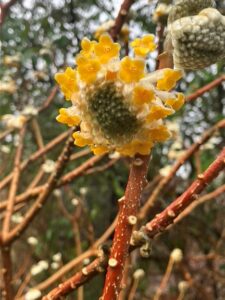 For late winter fragrance, Edgeworthia chrysantha is hard to beat. This is a relative of Daphne and has a similar fragrance. If you were just walking by it in bloom, it would be difficult to distinguish its fragrance from the common Daphne.
For late winter fragrance, Edgeworthia chrysantha is hard to beat. This is a relative of Daphne and has a similar fragrance. If you were just walking by it in bloom, it would be difficult to distinguish its fragrance from the common Daphne.
This deciduous plant has large leaves like a rhododendron and is sometimes called the Chinese paper bush because paper can be made from its bark. The silver-colored buds open to yellow flowers that appear in clusters at the tips of the branches. Edgeworthia has a unique way of branching because the branches emerge in a group of three and form a triangle.
About 20 years old, the specimen in my garden does receive some hot summer sun and the leaves quickly wilt but bounce back in the shade or with irrigation. While I have seen plants growing in full sun, some afternoon shade would be beneficial.
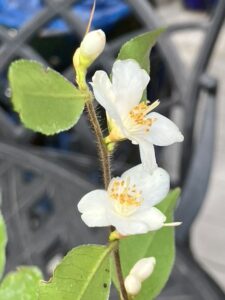 Despite our cool rainy spring, this has been a stellar year for camellias. While most of us are familiar with the large flowering types, there is another type that has dangling, pure white, small fragrant flowers. Winter-blooming Camellia transarisanensis is new to me and a superb looking shrub. It has an airy growth habit and looks as though it would make a good plant for an espalier.
Despite our cool rainy spring, this has been a stellar year for camellias. While most of us are familiar with the large flowering types, there is another type that has dangling, pure white, small fragrant flowers. Winter-blooming Camellia transarisanensis is new to me and a superb looking shrub. It has an airy growth habit and looks as though it would make a good plant for an espalier.
My neighbor’s plant is situated among some other shrubs and under a dogwood tree, so it is protected from the hot sun and wind. It is about 8 feet tall and the new growth has stunning bright red leaves. I was so impressed that last year I bought my own plant. It is in a protected location, and it came through the cold winter with no damage.
This would be an outstanding plant in a woodland garden setting or an espalier in a shady location.
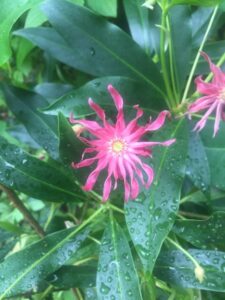 Illicium ‘Woodland Ruby’ (anise tree) has been in my garden for one year. The flowers were what attracted me to this shrub and the blooming season was much longer than I had expected. From late May through the summer, there were flowers.
Illicium ‘Woodland Ruby’ (anise tree) has been in my garden for one year. The flowers were what attracted me to this shrub and the blooming season was much longer than I had expected. From late May through the summer, there were flowers.
While the name ‘Woodland Ruby’ would indicate that the flowers are red, I would consider them more of a dark pink. One reference said that the flowers were shaped like starfish, but I would have never thought of that resemblance.
In just one year of growth, the specimen in my garden has doubled in size and is now about 4 feet in height. It seems to do better with some shade from the hot afternoon sun and a soil rich in organic matter.
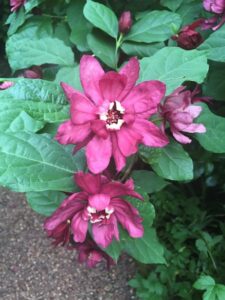 One tough plant that I have had in my garden for many years is Calycanthus × raulstonii ‘Hartlage Wine’. This deciduous shrub has maroon, wine-colored flowers, and it is one of the most talked about plants in my garden when it is in bloom. It is rare that we see flowers of this color and when the plant is in full bloom, late spring to early summer, the flowering is profuse.
One tough plant that I have had in my garden for many years is Calycanthus × raulstonii ‘Hartlage Wine’. This deciduous shrub has maroon, wine-colored flowers, and it is one of the most talked about plants in my garden when it is in bloom. It is rare that we see flowers of this color and when the plant is in full bloom, late spring to early summer, the flowering is profuse.
It is a very vigorous growing plant and often will need some pruning for space considerations. This Calycanthus does well in full sun and it has never had any winter damage. Give it room to spread: my plant is probably 8 feet tall and equally as wide, and I prune it every year.
Shrubs are clearly an important component of any garden. A few well-placed shrubs can become permanent focal plants in the garden. Your local garden center can give you creative ideas regarding shrub placement, along with suggestions for companion plants, such as other shrubs, ground covers or summer-flowering annuals. These are great options if you’re looking for something new, different a
These specimen-sized favorites command the spotlight

